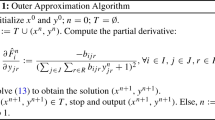Abstract
The paper is focused on discrete competitive facility location problem for an entering firm considering different customer behavior models: for essential goods, customers generally spread their buying power among all facilities within an attraction area, but if there are no facilities nearby, then customers choose a single highly attractive facility outside the attraction area to satisfy their demand. The new facility location model has been proposed considering the proportional customer choice rule for customers with facilities within the attraction area and the binary rule—for customers which facilities are located outside the attraction area. The model has been formulated as a non-linear binary programming problem and a heuristic optimization algorithm has been applied to find the optimal solutions for different instances of the problem using real geographical coordinates and population data of thousands of municipalities in Spain.


Similar content being viewed by others
Data Availibility
The datasets analysed during the current study are available from the corresponding author on reasonable request.
References
Drezner, T.: A review of competitive facility location in the plane. Logist. Res. 7, 114 (2014)
Eiselt, H., Marianov, V., Drezner, T.: Competitive location models. In: Laporte G., Nickel S., da Gama F.S. (eds.), Location Science, pp. 365–398 (2015)
ReVelle, C., Eiselt, H., Daskin, M.: A bibliography for some fundamental problem categories in discrete location science. Eur. J. Oper. Res. 184(3), 817–48 (2008)
Plastria, F.: Static competitive facility location: an overview of optimisation approaches. Eur. J. Oper. Res. 129, 461–470 (2001)
Plastria, F., Vanhaverbeke, L.: Discrete models for competitive location with foresight. Comput. Oper. Res. 35, 683–700 (2008)
Farahani, R.Z., Abedian, M., Sharahi, S.: In: Farahani R.Z. and Hekmatfar M. (eds.) Facility location: concepts, models, algorithms and case studies. Springer, pp. 347–372 (2009)
Fernández, P., Pelegrín, B., Lančinskas, A., Žilinskas, J.: New heuristic algorithms for discrete competitive location problems with binary and partially binary customer behavior. Comput. Oper. Res. 79, 12–18 (2017)
Grohmann, S., Urošević, D., Carrizosa, E., Mladenović, N.: Solving multifacility huff location models on networks using metaheuristic and exact approaches. Comput. Oper. Res. 78, 537–546 (2017)
Fernández, J., G.-Tóth, B., Redondo, J.L., Ortigosa, P.M.: The probabilistic customer’s choice rule with a threshold attraction value: effect on the location of competitive facilities in the plane. Comput. Oper. Res. 101, 234–249 (2019)
Serra, D., Eiselt, H.A., Laporte, G., ReVelle, C.S.: Market capture models under various customer-choice rules. Environ. Plann. B. Plann. Des. 26, 741–750 (1999)
Fernández, P., Pelegrín, B., Lančinskas, A., Žilinskas, J.: Exact and heuristic solutions of a discrete competitive location model with Pareto-Huff customer choice rule. J. Comput. Appl. Math. 385, 113200 (2021)
Drezner, T., Drezner, Z.: Finding the optimal solution to the Huff based competitive location model. CMS 1(2), 193–208 (2004)
Pelegrín, B., Fernández, P., García, M.D.: On tie breaking in competitive location under binary customer behavior. OMEGA Int. J. Manag. Sci. 52, 156–167 (2015)
Campos, C.M., Santos-Peñate, D.R., Moreno, J.A.: An exact procedure and LP formulations for the leader-follower location problem. TOP 18(1), 97–121 (2010)
Pelegrín, B., Redondo, J.L., Fernández, P., et al.: GASUB: finding global optima to discrete location problems by a genetic-like algorithm. J. Global Optim. 38, 249–264 (2007)
Sinnott, R.W.: Virtues of the haversine. Sky Telesc. 68(2), 158 (1984)
Lančinskas, A., Pascual, F., Pelegrín, B., ReVelle, C.S.: Improving solution of discrete competitive facility location problems. Optim. Lett. 11(2), 259–270 (2017)
Acknowledgements
This research has been supported by the Fundación Séneca (The Agency of Science and Technology of the Region of Murcia) under the research project 20817/PI/18.
Author information
Authors and Affiliations
Corresponding author
Additional information
Publisher's Note
Springer Nature remains neutral with regard to jurisdictional claims in published maps and institutional affiliations.
Rights and permissions
Springer Nature or its licensor holds exclusive rights to this article under a publishing agreement with the author(s) or other rightsholder(s); author self-archiving of the accepted manuscript version of this article is solely governed by the terms of such publishing agreement and applicable law.
About this article
Cite this article
Fernández, P., Lančinskas, A., Pelegrín, B. et al. A discrete competitive facility location model with proportional and binary rules sequentially applied. Optim Lett 17, 867–877 (2023). https://doi.org/10.1007/s11590-022-01938-x
Received:
Accepted:
Published:
Issue Date:
DOI: https://doi.org/10.1007/s11590-022-01938-x




